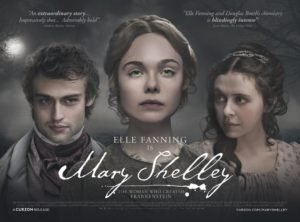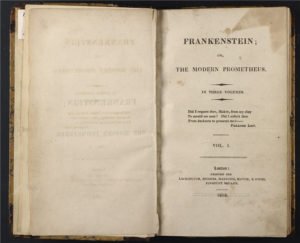'What did the Gothic mean to Mary Shelley?' Professor Angela Wright at Off the Shelf Festival
Today we offer a recap of Professor Angela Wright's (University of Sheffield) talk, 'Mary Shelley and the Gothic Tradition', delivered on October 19th as part of Off the Shelf: one of the UK's largest literary festivals.
 While Professor Wright's talk contributed to the range of Off the Shelf events celebrating the bicentenary of Frankenstein, she emphasised that Mary Shelley was not a 'one-hit-wonder' and encouraged the audience to explore, not only Shelley's other novels, but also her extensive and eclectic reading list. Professor Wright opened her talk by bringing attention to Mary Shelley as a reader of the Gothic through discussion of the 2017 film, Mary Shelley (directed by Haifaa al-Mansour).
While Professor Wright's talk contributed to the range of Off the Shelf events celebrating the bicentenary of Frankenstein, she emphasised that Mary Shelley was not a 'one-hit-wonder' and encouraged the audience to explore, not only Shelley's other novels, but also her extensive and eclectic reading list. Professor Wright opened her talk by bringing attention to Mary Shelley as a reader of the Gothic through discussion of the 2017 film, Mary Shelley (directed by Haifaa al-Mansour). Professor Wright noted that, for a film rife with inaccuracies, particularly in its portrayal of Percy Bysshe Shelley, there was a great moment of attention to detail.
Professor Wright noted that, for a film rife with inaccuracies, particularly in its portrayal of Percy Bysshe Shelley, there was a great moment of attention to detail. The book clutched in Mary's hand is The Castle of Wolfenbach: a Gothic novel by Eliza Parsons first published in 1793. 'The Gothic is anything but a passing fancy for Mary Shelley', Professor Wright stated, and this detail emphasises Mary as a reader of the Gothic: a genre that would come to influence, not only Frankenstein, but Mary's range of writings.
The book clutched in Mary's hand is The Castle of Wolfenbach: a Gothic novel by Eliza Parsons first published in 1793. 'The Gothic is anything but a passing fancy for Mary Shelley', Professor Wright stated, and this detail emphasises Mary as a reader of the Gothic: a genre that would come to influence, not only Frankenstein, but Mary's range of writings. Professor Wright drew the audience's attention to Mary and Percy's reading list with particular focus upon the Gothic readings from 1814-1815, including Ann Radcliffe's The Italian and The Mysteries of Udolpho. This Gothic influence, combined with allusions to Shakespeare, Dante, and Milton, is apparent in the creation account of the Creature, which was Mary's starting point when she began her novel in 1816. The listing of the Creature's body parts is Gothic in its provocation of terror, and the audience's attention was drawn to the tortured pain evoked by its 'watery eyes' and skin stretched taught across its face, but also alludes to the blazon tradition of Shakespeare's 'Sonnet 130'.
Professor Wright drew the audience's attention to Mary and Percy's reading list with particular focus upon the Gothic readings from 1814-1815, including Ann Radcliffe's The Italian and The Mysteries of Udolpho. This Gothic influence, combined with allusions to Shakespeare, Dante, and Milton, is apparent in the creation account of the Creature, which was Mary's starting point when she began her novel in 1816. The listing of the Creature's body parts is Gothic in its provocation of terror, and the audience's attention was drawn to the tortured pain evoked by its 'watery eyes' and skin stretched taught across its face, but also alludes to the blazon tradition of Shakespeare's 'Sonnet 130'. Ultimately, Professor Wright stated, it is the 'silence and marginalization of female characters' that makes Frankenstein 'a supremely Gothic novel for me'. This destructive silencing is evocatively imaged in the 1994 film, Mary Shelley's Frankenstein (directed by Kenneth Branagh). Professor Wright noted how, here, cinematic divergence from the novel was successful: as Victor and the Creature each take hold of his newly-created female companion, their struggle results in her being torn limb from limb. In demanding a companion, the Creature becomes a destructive and shadowy double of his creator.
Ultimately, Professor Wright stated, it is the 'silence and marginalization of female characters' that makes Frankenstein 'a supremely Gothic novel for me'. This destructive silencing is evocatively imaged in the 1994 film, Mary Shelley's Frankenstein (directed by Kenneth Branagh). Professor Wright noted how, here, cinematic divergence from the novel was successful: as Victor and the Creature each take hold of his newly-created female companion, their struggle results in her being torn limb from limb. In demanding a companion, the Creature becomes a destructive and shadowy double of his creator. In the 1831 edition of Frankenstein, Shelley becomes more consciously aware of her novel's Gothic heritage and expresses this through the evocation of terror. She recounts the reading of 'volumes of ghost stories, translated from the German into French', Fantasmagoriana, at the Villa Diodati in the summer of 1816. The 'uneasy, half-vital motion' of 'the hideous phantasm of a man' in Mary's recollected dream links to galvanism, and the repetitions of 'I saw' force the reader to 'feel the trauma of her nightmare', Professor Wright notes. As Shelley moves through allusions to Milton, Dante, and Goethe in her revolutionary novel, she seems to emphasise that the 'literary past cannot adequately explain the present. New models are needed'.
In the 1831 edition of Frankenstein, Shelley becomes more consciously aware of her novel's Gothic heritage and expresses this through the evocation of terror. She recounts the reading of 'volumes of ghost stories, translated from the German into French', Fantasmagoriana, at the Villa Diodati in the summer of 1816. The 'uneasy, half-vital motion' of 'the hideous phantasm of a man' in Mary's recollected dream links to galvanism, and the repetitions of 'I saw' force the reader to 'feel the trauma of her nightmare', Professor Wright notes. As Shelley moves through allusions to Milton, Dante, and Goethe in her revolutionary novel, she seems to emphasise that the 'literary past cannot adequately explain the present. New models are needed'. The lecture drew to a close with Professor Wright's examination of 'the silent editor of Walton's letters', his sister, Margaret Walton Saville, and she argued that female editorship becomes a persistent preoccupation, especially in Shelley’s third and fourth novels Valperga (1823) and The Last Man (1826). In Shelley's final novel, Falkner (1837), she comes full-circle in her literary career by naming the protagonist of what she knew to be her last work, 'Elizabeth', obviously recalling Frankenstein's Elizabeth Lavenza. The inaccuracies of the Shelleys' relationship in the 2017 film betray the reciprocity of their literary partnership, but the film offers glints of authentic detail, such as the lasting influence of the Gothic upon Mary Shelley.
The lecture drew to a close with Professor Wright's examination of 'the silent editor of Walton's letters', his sister, Margaret Walton Saville, and she argued that female editorship becomes a persistent preoccupation, especially in Shelley’s third and fourth novels Valperga (1823) and The Last Man (1826). In Shelley's final novel, Falkner (1837), she comes full-circle in her literary career by naming the protagonist of what she knew to be her last work, 'Elizabeth', obviously recalling Frankenstein's Elizabeth Lavenza. The inaccuracies of the Shelleys' relationship in the 2017 film betray the reciprocity of their literary partnership, but the film offers glints of authentic detail, such as the lasting influence of the Gothic upon Mary Shelley.
For more on Mary Shelley and the Gothic, see Professor Angela Wright's Mary Shelley (University of Wales Press, 2018).
You can also access Mary Shelley's extensive reading list on Romantic Circles here.


